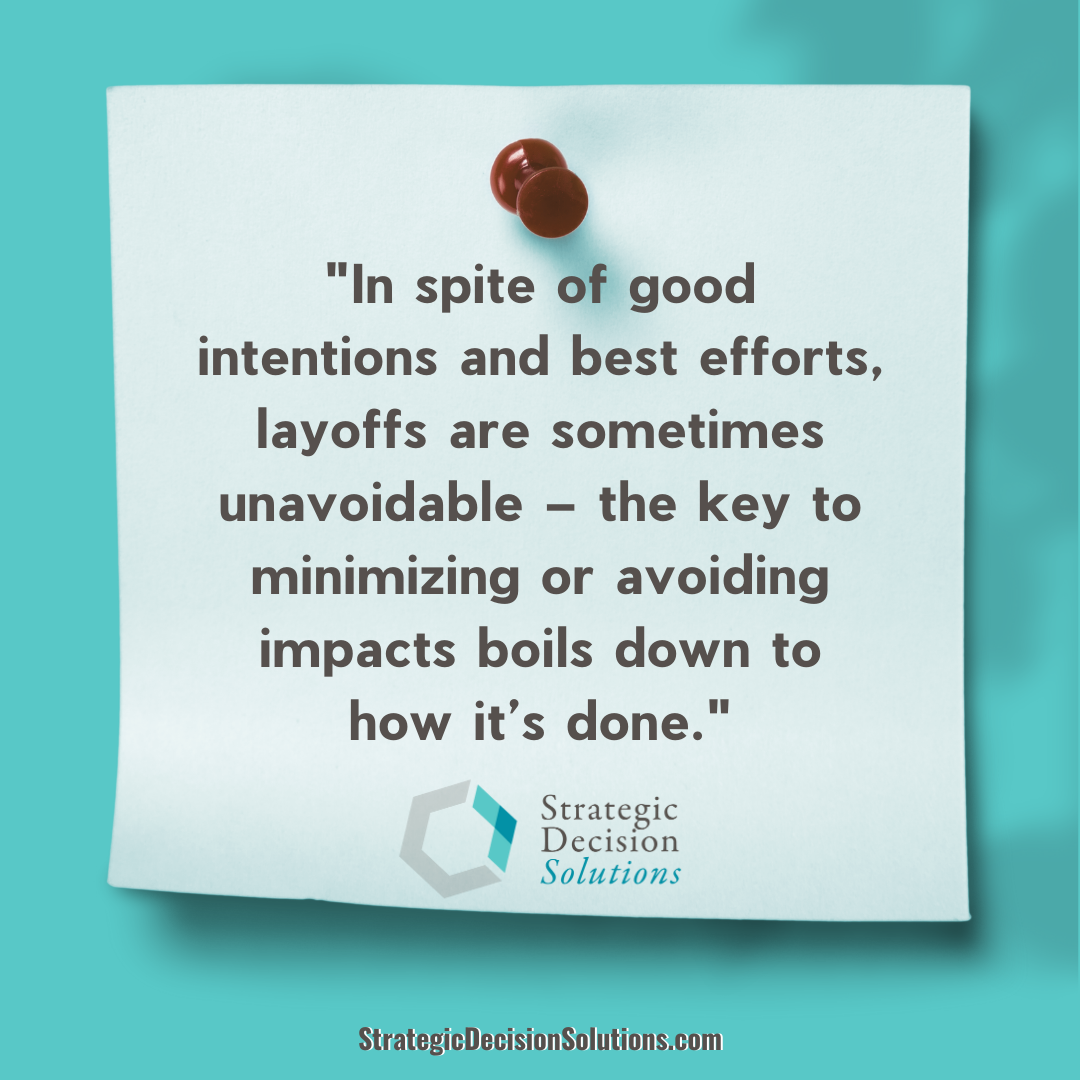Losing a job is one of the more stressful and emotional events a human can endure and is something we’ve all encountered, one way or another.
Over the last year, layoffs have been making the news on a seemingly regular basis. While largely been contained in the tech-related industries, recent reports indicate that layoffs have been occurring in finance, retail, and elsewhere, triggered by increased recession fears and sagging customer demand.
When finances get tight, many companies’ first resort is to reduce an arbitrary number of workers in the hopes this will return the company to profitability. More often than not though, it isn’t necessary to reduce a workforce to save money. An increasing number of studies seem to indicate that layoffs end up costing more in the long run.
Layoffs are part of the expansive topic of talent. I had the pleasure a few months ago of speaking with Julian Rierson on general talent risks and opportunities. This article on the changing nature of work is another example.
After reading news about more layoffs in recent months and the strong possibility of more looming, it’s supremely important for executives to have a clear understanding of the risks and tradeoffs.
For answers to questions like these, I turned to HR and risk consultant Janet Yienger to learn more. After speaking to Janet, it became clear how the subject of layoffs represents a golden opportunity for ERM to deliver greater value to the organization, not by minimizing or avoiding risks, but also ensuring that strategic goals can still be met if layoffs have to occur.
While there may [emphasis on “may”] be some short-term financial or profitability benefits for a company, simply saying “all departments need to cut 10% of its staff” without concern for risk and strategy can be disastrous in a number of ways, including:
- Reputation – the moment any rumors about layoffs begin to circulate, it’s guaranteed to end up on social media where only the “bad” news will be discussed. If layoffs are handled especially poorly, the reputation damage could take years to repair. And when it is time for the company to start hiring again, people will hesitate to join their workforce since the company will have a history of layoffs when times get tough.
- Morale/culture – not only does a company have to consider the people losing their jobs but also those who did not. Witnessing others lose their jobs can have an immediate effect on their commitment and level of engagement. Instead of giving 100%, they’re only motivated to do the minimum. Increased voluntary turnover is also a real possibility, with one study published in the Academy of Management Journal showing how a 1% reduction in staff can lead to a 31% increase in voluntary resignations, which compounds the morale issues.
- Recruiting – companies who layoff workers still have staffing needs. While one area may let several people go, other areas may still be hiring. However, when news about layoffs begins to reach prospective workers whose skills the company needs, it will be extra challenging to entice them to accept a job offer or even apply in the first place. Also, if a layoff is handled poorly, and most of all, the company is not transparent with its employees, the company could lose the chance to hire the people back in the future.
- Institutional knowledge – executives should never underestimate the value of institutional knowledge, but this unfortunately is often forgotten, especially when a company’s layoffs target more senior employees. Without careful preparation, this loss of institutional and historical knowledge can be disastrous, especially for strategic initiatives. Also, any relationships more senior personnel have developed, especially in sales, can lead to less trust from prospective customers and, therefore, less revenue.
- Financial – the reactive approach or mindset may think a company can save money through layoffs, but this is usually temporary. Many companies will offer severance packages and/or continued benefits to soften the blow to employees, but this all costs money. Layoffs and the message they send can be a red flag to long-term investors. (Conversely, investors focused only on short-term results will sometimes push for layoffs.) If any relevant laws are not carefully followed, the company could be hit with huge fines.
- Legal – a number of state and federal laws govern how people can be let go. The federal Worker Adjustment and Retraining Notification (WARN Act) is one such law that larger employers should be mindful of during layoffs. These laws don’t prohibit layoffs, but they must be followed. If any laws are broken, the company could end up having to work extra hard after the fact to correct any deficiencies, in addition to facing more reputation/PR damage.
- Loss of momentum on strategic initiatives – woven throughout these different impacts of layoffs is their effect on accomplishing strategic goals. If morale collapses or the institutional knowledge is no longer there, the company’s long-term success and resiliency can be put in jeopardy to the point that it never recovers.
These risks and others caused by layoffs will impact companies differently, of course, but all I can say is ouch!!
As explained in this HBR article on what companies still get wrong about layoffs:
Short-term cost savings provided by a layoff are overshadowed by bad publicity, loss of knowledge, weakened engagement, higher voluntary turnover, and lower innovation – all of which hurts profits in the long run.
And this doesn’t account for how layoffs can impact affected workers personally…it can take an average of two years for someone to recover from something like this.
These expansive impacts are probably why many suggest avoiding them altogether, if at all possible.
Fortunately a company has other options instead of eliminating people’s jobs.
The possibility of an economic downturn or some other factor like a failed product launch could necessitate some hard choices. In many cases, layoffs represent a scarcity mindset that can be problematic in today’s business environment.
Thankfully, layoffs are just one of several options a company has.
Retraining for other roles in the company where needs are greater is one such option.
For example, anyone with any sort of data background or aptitude can be retrained into a business analyst role, especially with the focus on big data and analytics. Many companies facing hardships will try to either cross-train employees or find other areas of the company to where the employee can transition.
Another option is freezing pay rates or reducing pay in exchange for fewer hours. Some employees will really like the increased flexibility, and retaining benefits will be a huge plus for many employees since these can be more valuable than the pay itself.
Another option to consider is a subset of the above pay freeze option – pay rates for high performers can stay intact but freeze pay for average performers.
During the tumultuous onset of the COVID pandemic, many companies would furlough workers and some executives would forego their base salary altogether in order to avoid laying workers off. The ones that ended up laying people off en masse didn’t make it.
Making every effort to keep people on board can build goodwill among not only employees, but investors, consumers, and even the general community around the company that depends on the jobs and spillover effects a large employer brings to an area.
In spite of good intentions and best efforts though, layoffs are sometimes unavoidable – the key to minimizing negative impacts really boils down to how they’re executed.
Sometimes layoffs are unavoidable, as is the case of shifting demands following a hiring surge for tech and online retail companies at the onset of the pandemic (assuming there was no option for retraining). If this ends up being the case at your company, the big point to keep in mind, according to Janet Yienger, is:
Humans are the most important assets a company has. You have to be careful when messing with humans.
Jobs and livelihoods are no laughing matter. Very few things in life are more stressful than losing a job.
This is why companies must be transparent with all of its employees – both the employees directly impacted by a layoff and the employees staying. It’s also where HR and risk management need to be there to ask management the hard questions of why this action is being taken, what risks apply and to what extent, and what laws apply.
Clear criteria that’s uniformly applied is the first step. Will layoffs be based on performance, seniority, or a combination?
This is where a solid performance management program is so important.
This performance system is also helpful in identifying the top performers who can continue pursuing strategic objectives. Every job should connect with the strategic plan in some way. Knowing who the good employees (a/k/a above average performers) are and ensuring they stay engaged with the strategic plan helps alleviate one of the more long-term impacts of layoffs.
Carefully crafted severance packages (i.e., pay and benefits) can soften the blow and give the employee some breathing room as they search for a new job.
In the end, before initiating the layoffs or even discussing them outside a tight circle of executives, HR, and Risk, the company must have a clear plan for executing and communicating the reasons for the layoffs. Here are some questions that companies need to answer before communicating with affected employees:
- What do they want employees to think happened and why?
- Do the employees feel they were treated properly?
- What are the employees saying and feeling? Is this response manageable?
The same is true for employees who are still there – do they feel their jobs are safe? How much trust did the company lose in this process?
ERM should coordinate with impacted departments to ensure risks and mitigation activities do not fall by the wayside. Being careless can result in the consequences mentioned above and then some.
If layoffs are unavoidable, the how will be vital – how to treat people, how to preserve knowledge, how to execute work without any hiccups, and how to recruit going forward will be key to pulling it off as seamlessly as possible.
With all of these headaches, it’s easy to see why experts recommend layoffs be a truly last resort.
If your company has opted for layoffs in the past, how were they handled?
It will be interesting to see how companies tackle this topic going forward. Will companies simply take a reactive approach and send people home at the first whiff of trouble? Or will management be more proactive and ensure strategic goals and initiatives remain intact?
To share your thoughts, please leave a comment below.
If your company is in the midst of struggles like this and don’t know what can be done to handle them in a way that preserves value, please don’t hesitate to reach out to discuss the current situation and potential options.








